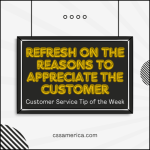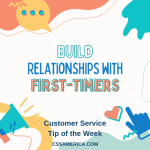I try to make these tips around 300 words, but oftentimes I’m North of 400. I work hard to pare down the words because I don’t want one or two core points being lost in a barrage of verbosity.
Phrases like lost in a barrage of verbosity are the things that might come out of my mouth initially. But I try to avoid these phrases when sending messages because I want to be clear to the person with whom I’m speaking, so that they can more quickly and easily understand.
Part of how you convey respect in customer service is how you communicate with others, and one often overlooked method of communication is writing. Our e-mails, in particular, could be more clear, more crisp.
When I say crisp, look at your e-mails sent to co-workers and customers. Can the key information be gleaned in under 60 seconds?
If not, here are a few quick ways to make your writing crisp:
- Take out the prepositional phrases. Did I really need to write “to the person with whom I’m speaking” above?
- Eliminate the acronyms that are going to create follow-up communications requesting clarification.
- Go for the shorter sentences rather than the long.
- Use those bullet points.
- Highlight the 1-2 points that you want them to take away from the message.
Be clear, but be a bit of a minimalist.
I naturally use a lot of words when I write, so I have to proof and narrow my initial draft. Maybe it takes me an extra minute, but out of respect for the customer/co-worker, I try to pare it down so they can quickly and clearly understand what to do next or what I’m trying to convey.
In business writing for customer service, communicate crisply.
Signup for FREE Tips! Contact Us More Resources for You Visit Our Home Page
























